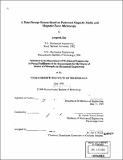| dc.contributor.advisor | Kamal Youcef-Toumi. | en_US |
| dc.contributor.author | Bae, Jungmok | en_US |
| dc.contributor.other | Massachusetts Institute of Technology. Dept. of Mechanical Engineering. | en_US |
| dc.date.accessioned | 2009-06-30T18:49:57Z | |
| dc.date.available | 2009-06-30T18:49:57Z | |
| dc.date.copyright | 1999 | en_US |
| dc.date.issued | 1999 | en_US |
| dc.identifier.uri | http://hdl.handle.net/1721.1/46281 | |
| dc.description | Thesis (Ph.D.)--Massachusetts Institute of Technology, Dept. of Mechanical Engineering, 1999. | en_US |
| dc.description | Includes bibliographical references (p. 145-154). | en_US |
| dc.description.abstract | In recent years, there are increasing demands for the high performance data storage systems. Periodic arrays of nanostructured magnetic pillars have been proposed as a patterned medium for high density data storage. In patterned media, each single domain magnetic pillar is used to store one bit of data. This media can theoretically provide an extremely high recording density. A writing method, based on the point magnetic recording scheme, is suggested and tested experimentally in this thesis. By using this method, a recording density of as high as 16 Gbits/in2 can be achieved with this perpendicular patterned media. The point magnetic recording (PMR) is based on the magnetic force microscopy (MFM). In this scheme, the MFM tip comes in contact with the sample and the magnetic field is applied by an external coil. The resulting magnetic field, concentrated near the tip, is used in the writing process. The exact writing field used in PMR process was experimentally measured and verified by simulation using a commercial magnetostatic simulation tool. By using this method, the important properties of the patterned media were studied. First, the switching field, defined as the external field at which a pillar reverses its magnetization, was measured. The curling mode model agreed well with the experimental data obtained from the Ni pillars of 90 nm in diameter and 180 nm in height. The samples used in the measurement were fabricated using lithography and electroplating with magnetic materials such as Ni and Co. The average switching field was 420 Oe but a high non-uniformity, ranging from 200 Oe to 700 Oe was observed. Secondly, the interaction field between the pillars was studied. For the first time, we measured the interaction field directly from pillars with spacing as small as 200 nm using the PMR method. Corresponding results were generated using a model based on the dipole approximation and compared with the experimental data. A good agreement was obtained. This thesis, also, discusses some of the system level issues including the design related to the high data rate and the tracking of the individual bits for precise positioning of the head during the writing process. | en_US |
| dc.description.statementofresponsibility | by Jungmok Bae. | en_US |
| dc.format.extent | 154 p. | en_US |
| dc.language.iso | eng | en_US |
| dc.publisher | Massachusetts Institute of Technology | en_US |
| dc.rights | M.I.T. theses are protected by
copyright. They may be viewed from this source for any purpose, but
reproduction or distribution in any format is prohibited without written
permission. See provided URL for inquiries about permission. | en_US |
| dc.rights.uri | http://dspace.mit.edu/handle/1721.1/7582 | en_US |
| dc.subject | Mechanical Engineering. | en_US |
| dc.title | A data storage system based on patterned magnetic media and magnetic force microscopy | en_US |
| dc.type | Thesis | en_US |
| dc.description.degree | Ph.D. | en_US |
| dc.contributor.department | Massachusetts Institute of Technology. Department of Mechanical Engineering | |
| dc.identifier.oclc | 48171930 | en_US |
